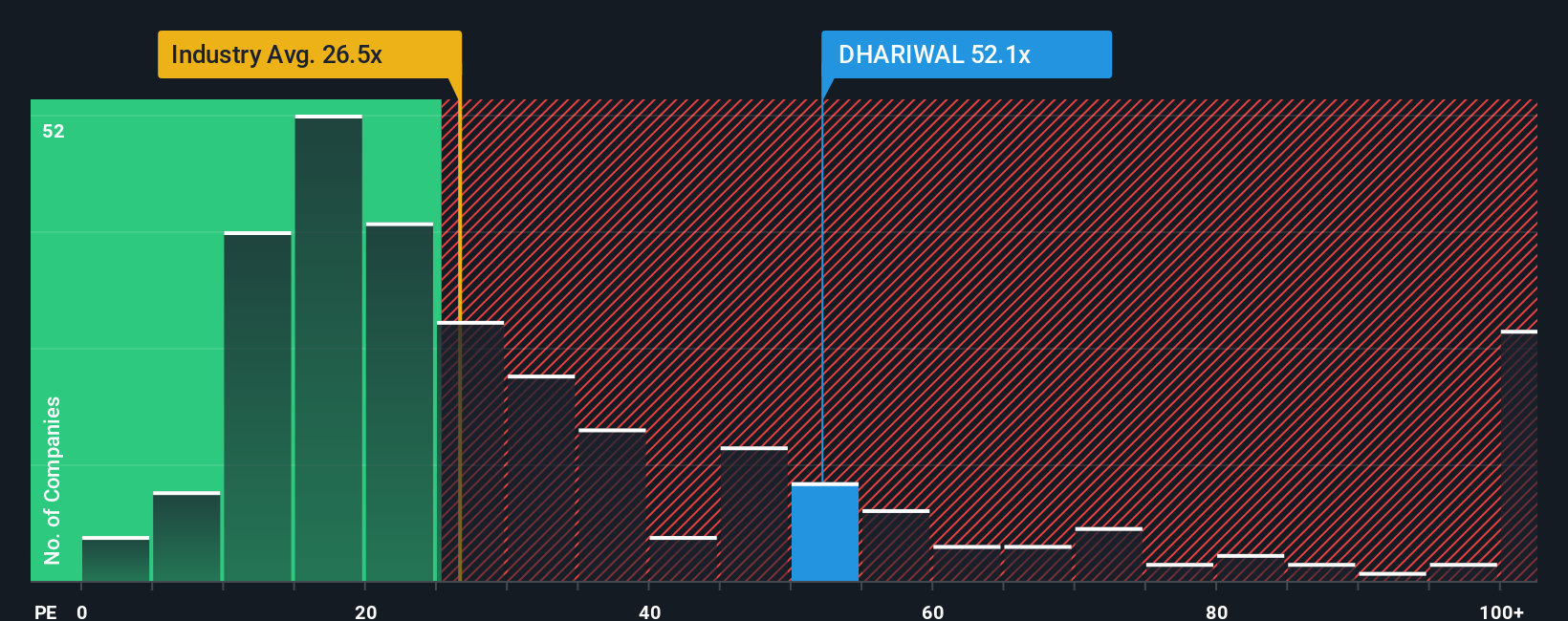Optimistic Investors Push Dhariwal Corp Limited (NSE:DHARIWAL) Shares Up 27% But Growth Is Lacking
Despite an already strong run, Dhariwal Corp Limited (NSE:DHARIWAL) shares have been powering on, with a gain of 27% in the last thirty days. The last 30 days bring the annual gain to a very sharp 34%.
Following the firm bounce in price, given close to half the companies in India have price-to-earnings ratios (or "P/E's") below 27x, you may consider Dhariwal as a stock to avoid entirely with its 52.1x P/E ratio. However, the P/E might be quite high for a reason and it requires further investigation to determine if it's justified.
As an illustration, earnings have deteriorated at Dhariwal over the last year, which is not ideal at all. It might be that many expect the company to still outplay most other companies over the coming period, which has kept the P/E from collapsing. You'd really hope so, otherwise you're paying a pretty hefty price for no particular reason.
Check out our latest analysis for Dhariwal

Is There Enough Growth For Dhariwal?
There's an inherent assumption that a company should far outperform the market for P/E ratios like Dhariwal's to be considered reasonable.
Retrospectively, the last year delivered a frustrating 36% decrease to the company's bottom line. However, a few very strong years before that means that it was still able to grow EPS by an impressive 83% in total over the last three years. So we can start by confirming that the company has generally done a very good job of growing earnings over that time, even though it had some hiccups along the way.
This is in contrast to the rest of the market, which is expected to grow by 25% over the next year, materially higher than the company's recent medium-term annualised growth rates.
In light of this, it's alarming that Dhariwal's P/E sits above the majority of other companies. It seems most investors are ignoring the fairly limited recent growth rates and are hoping for a turnaround in the company's business prospects. There's a good chance existing shareholders are setting themselves up for future disappointment if the P/E falls to levels more in line with recent growth rates.
The Final Word
The strong share price surge has got Dhariwal's P/E rushing to great heights as well. We'd say the price-to-earnings ratio's power isn't primarily as a valuation instrument but rather to gauge current investor sentiment and future expectations.
Our examination of Dhariwal revealed its three-year earnings trends aren't impacting its high P/E anywhere near as much as we would have predicted, given they look worse than current market expectations. When we see weak earnings with slower than market growth, we suspect the share price is at risk of declining, sending the high P/E lower. Unless the recent medium-term conditions improve markedly, it's very challenging to accept these prices as being reasonable.
We don't want to rain on the parade too much, but we did also find 3 warning signs for Dhariwal (2 are potentially serious!) that you need to be mindful of.
Of course, you might also be able to find a better stock than Dhariwal. So you may wish to see this free collection of other companies that have reasonable P/E ratios and have grown earnings strongly.
New: Manage All Your Stock Portfolios in One Place
We've created the ultimate portfolio companion for stock investors, and it's free.
• Connect an unlimited number of Portfolios and see your total in one currency
• Be alerted to new Warning Signs or Risks via email or mobile
• Track the Fair Value of your stocks
Have feedback on this article? Concerned about the content? Get in touch with us directly. Alternatively, email editorial-team (at) simplywallst.com.
This article by Simply Wall St is general in nature. We provide commentary based on historical data and analyst forecasts only using an unbiased methodology and our articles are not intended to be financial advice. It does not constitute a recommendation to buy or sell any stock, and does not take account of your objectives, or your financial situation. We aim to bring you long-term focused analysis driven by fundamental data. Note that our analysis may not factor in the latest price-sensitive company announcements or qualitative material. Simply Wall St has no position in any stocks mentioned.
About NSEI:DHARIWAL
Dhariwal
Engages in the processing, purchasing, selling, importing, and trading various types of wax products in India and internationally.
Adequate balance sheet with low risk.
Market Insights
Community Narratives




